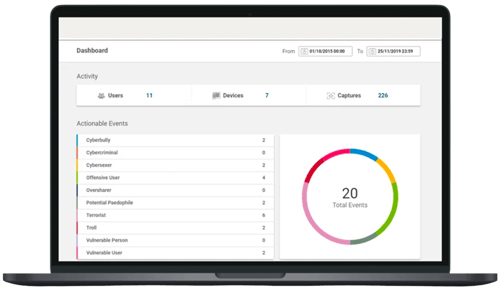Introducing Digital Safeguarding Technology
Digital Safeguarding Technology alerts schools to students whose safety, wellbeing, or even lives are at risk as a result of their online behaviours. Such is its importance, it is being rapidly adopted by schools throughout the UK and USA and is now available to schools in New Zealand.
This web page provides a complete guide for school leaders and pastoral staff coming to this technology for the first time. We hope it answers your questions. If you would like to arrange a demo or find out more, please contact us.
What is Digital Safeguarding Technology?
What a student says, does, says, or shares in their digital life can expose them to harm or reveal other concerns they may be experiencing. Because a child’s digital world is commonly off limits to their responsible adults, these risks slip under the radar and school leaders and parents are powerless to intervene.
Digital Safeguarding Technology makes invisible risks visible. It enables schools to intervene fast, remove the student from harm’s way and guide them back on track.


How it works
Digital Safeguarding Technology is both a software and a service. An agent sits on the student’s school-owned device and is only activated when there is a suspected risk to a student’s wellbeing, health or life based on what they do, say or share.
The technology immediately removes false positives and grades the risk. Low risks go into a portal for the school to review next time they log in. Higher risks are sent to a team of highly trained human moderators who assess the authenticity of the risk and grade its severity. If the risk is high, they will email your school’s nominated staff to alert them. If the risk is very high, including a danger to health or life, they will phone them, 24/7. This happens within minutes of the risk being detected.
Why are schools around the world adopting Digital Safeguarding Technology?
Students regularly do things or share feelings or intentions in their digital lives that they wouldn’t reveal to adults. The problem arises when these behaviours suggest they are at risk.
Common alerts include discussions around mental health, self-harm, incidents of cyberbullying, drugs, and suicidal ideation.
Research by Linewize, for example, showed that 95% of teachers relied on students to tell them if they were being cyberbullied. But only 5% of students said they would ever confide in an adult.
That’s an alarming disconnect and creates a gap that children can and do fall through.
A school’s inability to see these risks prevents them from intervening or intervening in time. We call it the iceberg effect, and it’s a real and present concern for schools everywhere.
Digital Safeguarding Technology reduces the Iceberg Effect by making the invisible risks visible.
Offline risks
you can see

Changes in behaviour. Injuries/ bruises, tip-offs from peers, absenteeism.
Online risks
you can't see

Online bullying or conversations about drugs/extremism/being harmed, hidden bruises/injuries, unspoken negative feelings and thoughts.
Risks to children online are increasing
When risks become visible, pastoral staff can initiate faster interventions; they can remove students from imminent danger, minimise incident escalation as well as gain vital insight into unsafe online behaviours to provide better education and awareness across their school community. Students in New Zealand spend more time on digital devices than ever, and the associated risks and harms are rising in accordance.
Self-harm
20% of young New Zealanders have researched how to self-harm online
Mental health issues
1 in 5 of young New Zealanders will be affected by depression or anxiety
Cyberbullying
1 in 5 young people in New Zealand experiences online bullying every year
Grooming & exploitation
eSafety Commission reported a 129% increase in reports of child sexual exploitation material in 2020
Sexting/Nudes
4% of young people in New Zealand have shared nude images (aged between 14-17)
Suicide
Suicide rates among New Zealand teens are the second highest in the developed world
Free resource for principals, senior leadership, pastoral staff and IT
Learn how digital safeguarding technology is being used across schools to:
- Know if your school is missing vulnerable students
- Guide students in building digital safety culture
- Enable staff to intervene with safeguarding technology
/AU-Thumbnail-Minarah-Case-Study.png?width=290&height=400&name=AU-Thumbnail-Minarah-Case-Study.png)
Benefits of Digital Safeguarding Technology
For Students
Students are protected 24/7, 365 days a year
Early detection means early intervention and more positive outcomes for the student
Prevents at-risk students from going unnoticed or noticed too late
Events affecting academic performance can be spotted and addressed early
Saves student lives
For Schools
Avoids incident escalation and reputational damage
Saves the cost and administrative burden of employing dedicated teams to review risks.
Positions a school as a leader in student safety and wellbeing
Provides parents with peace of mind that any unseen risks with their child can be spotted
Provides evidence to support digital wellness education and helps to develop digitally savvy students.
Linewize Monitor - A closer look
Linewize Monitor protects over 1 million students
Got questions?
Take a tour with one of our product experts.
Features
Using a combination of AI and a team of highly trained human moderators, Linewize Digital Safeguarding Technology finds and assesses students at risk based on what they do or say in their digital lives.
Real-time proactive monitoring
User activity is auto-moderated in real time, alerting any risks and allowing for early intervention.
Intuitive and simple interface
Incidents are displayed clearly, allowing you to quickly evaluate any concerns.
Artificial intelligence
Our automated “first layer” of intelligence ensures alerts are timely and effective, highlighting issues that a 100% human-moderated product could miss.
Risk-assesses the entire screen
The only solution of its kind to risk-assess the full screen, not just the URL; dramatically reducing false positives and providing valuable detail when deciding on the most appropriate support intervention.
Works online and offline
Works offline, capturing risk events even when the device is disconnected from the internet. When the device re-connects, data is transmitted to Linewize Monitor for analysis.
Appropriate alerting
Choose an alerting configuration that suits both the school and students and ensure pastoral staff only receive the alerts they require.
Linewize Monitor assesses student digital wellbeing risks in more categories than any other solution.
Cyberbullying
Drugs
Extremism
Suicide
Abuse
Violence
Oversharing